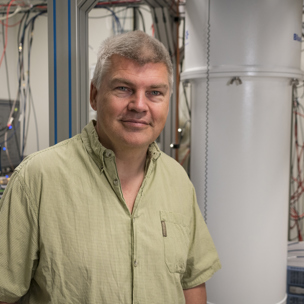Why a Swedish quantum agenda?
A race is under way in quantum technology, a field of research and innovation that is predicted to revolutionise the future development of computers, secure communications and a more efficient energy supply. Several Swedish research bodies have now jointly drawn up an agenda setting out how Sweden can secure its place on the technological train that no one wants to miss.

One of the people involved in this work is Per Delsing, Programme Director of the Wallenberg Centre for Quantum Technology (WAQT) and Fellow of IVA. We asked him about the purpose of the Swedish quantum agenda.
Tell us about the agenda. Who is behind it and what is its purpose?
– This is an initiative by Vinnova, the Swedish Research Council, SweLife, RISE and the Wallenberg Centre for Quantum Technology. What we have produced is an agenda for quantum technology in Sweden, where we try to give a holistic picture of the situation nationally when it comes to research, innovation and education in the quantum field. What are the opportunities and strengths, and what are the challenges? Our intention here is for Sweden to come together and create a national strategy for this with clear goals. What do we want to achieve in the quantum field and how will we get there? Ultimately, the initiative has to come from the political sphere.
There is talk about an ongoing quantum race, a technological race where nobody wants to be left behind. Why is it so important for Sweden to be involved in the development of quantum technology?
– Quantum technology comes from our emerging knowledge in recent decades of how to control ‘quantum systems’. This means that we can control and manipulate individual atoms and molecules, which opens up completely new opportunities to do things we couldn’t have done before. For example, we can build quantum computers that work in a completely different way from today’s computers and can do things that today’s computers can’t. It is said that the difference between a quantum computer and today’s supercomputers is greater than the difference between a supercomputer and a classic abacus.
Give us some concrete examples of what a quantum computer can do.
– A quantum computer can make very advanced simulations where you can test a lot of different solutions, such as how to build new molecules to create new drugs or new materials. Or how to solve very complicated logistical problems. For example, how can an airline work out the most efficient way to use its hundreds of aircraft and hundreds of crew to serve hundreds of different destinations, when there may be more permutations than there are particles in the universe? These are just some of the things that we already know a quantum computer can help us with. Then there is a whole other field of research aimed at understanding what might be possible in the future.
In your agenda, you write that “in order for Sweden to take advantage of the opportunities offered by quantum technology, we need concrete national goals and a well-financed national quantum strategy”. Why do we need this? Don’t we already have competitive research in the field of quantum technology in Sweden?
– I would say that we don’t have all that many major initiatives. The only sizeable initiative we have at the moment is actually WACQT, but this is a privately financed research programme that is time-limited. So there needs to be a holistic approach to this, and coordination of different activities. We do have funding for research, but there is no equivalent investment in education, or in innovation and the transfer of technology. We need all these elements to guarantee that we have a functioning ecosystem within quantum technology.
How is Sweden doing? Are other countries ahead of us in terms of research and technological development in the quantum field?
– Sweden is doing well, but there are many other countries that are investing heavily in this area. So there is a race in progress, especially when it comes to building quantum computers. In terms of research, Sweden is doing well, but we lack these other elements of education, innovation and technology transfer. And it is not just about initiatives that allow us to be involved in building the quantum computers of the future. There are also other aspects of quantum technology that we need to keep pace with, i.e. quantum communication and quantum sensing, which are much closer to market right now.
The agenda highlights nine development areas where you feel that Sweden needs to invest. Which ones would you say are most important?
– I definitely think we need to invest a lot more in innovation and technology transfer. At present, we are investing SEK 1.5 billion in research into quantum technology, while the investments we have in converting research and ensuring that it benefits society stand at just a few tens of millions. So the focus on innovation is tiny compared to the investment in research. We also have to make sure that we develop a more long-term strategy when it comes to research. The initiative that the Wallenberg Foundation is currently running was only ever meant to last for 12 years, and now only seven remain. What happens when the time runs out? It is important that we don’t then have a big gap, and that we are already starting to build up other initiatives with other financing, not just private initiatives.
– Other areas in which it is extremely important to start investing right now include raising skill levels and actually setting up courses, and not just in quantum physics or quantum chemistry. We also need education provision in quantum technology, producing people who have the skills to apply the research and see how it could be developed into a device or a method that can actually be used and sold.
You say that politicians must bear the ultimate responsibility for ensuring that investments are made. Does this mean that the government should also stump up the money?
– Of course it can come from several sources, but the government is a key player. In Sweden, almost all the money currently comes from the private sector, which is not the case in many other countries. The government is the main funder of both research and innovation in the field of quantum technology.
Doesn’t the business community have to do its bit?
– It goes without saying that the business community must also invest in this, and they already are. Take Google and IBM, for example, which are currently investing huge sums in the development of quantum computers. There are also a number of Swedish companies that are not yet involved in quantum technology, but are already realising that it will be important for their continued competitiveness, and so they need to start investing in building up competencies. We are talking about companies such as Saab, Ericsson, Volvo, AstraZeneca and so on.
If you were to choose one measure that Sweden needs to take now in order to stay in the running in this quantum race, what would it be?
– The very first step is to establish an objective: Where does Sweden want to be in quantum technology within 10 years? The government must set the level of ambition, and once it has been set, we need the funding to be available and a strategy to be in place for achieving the stated goals.

